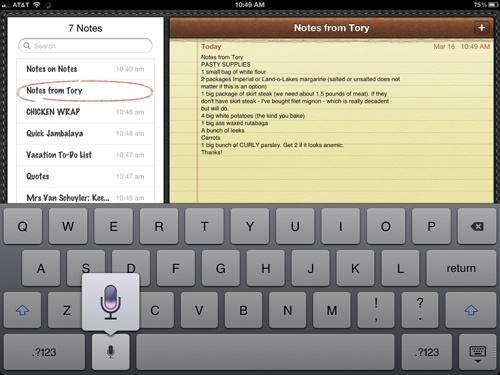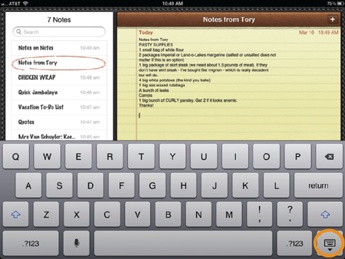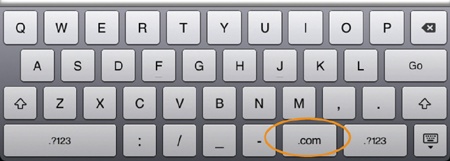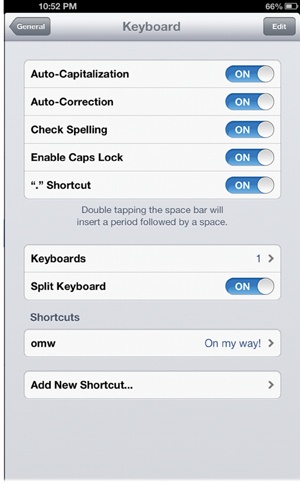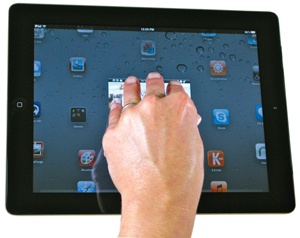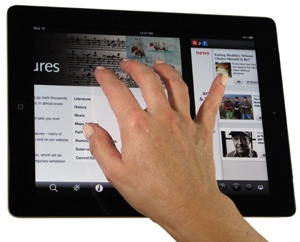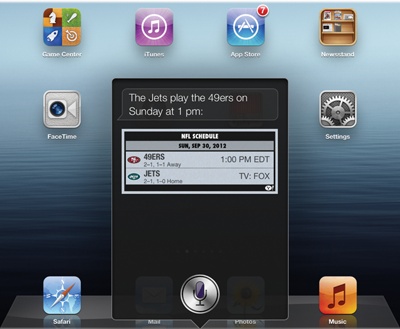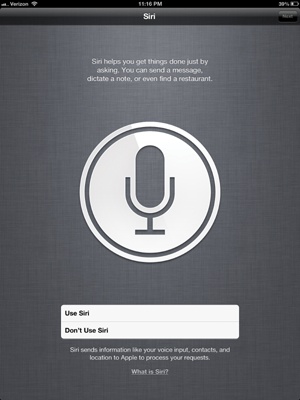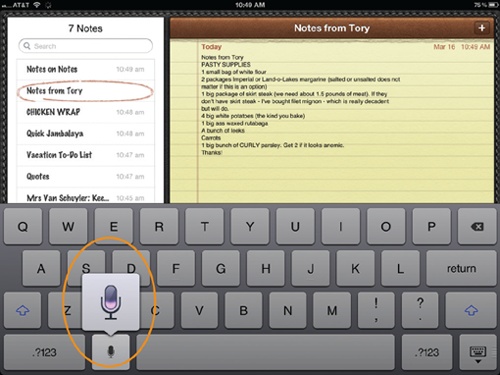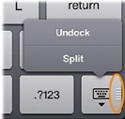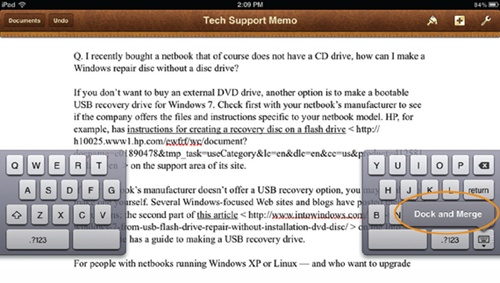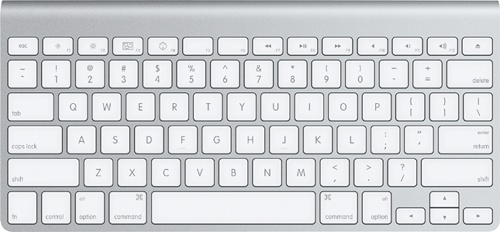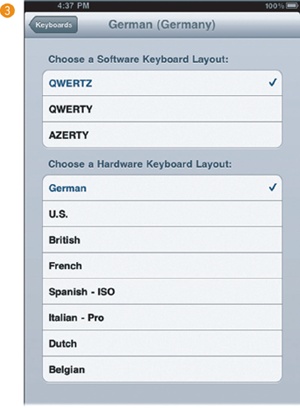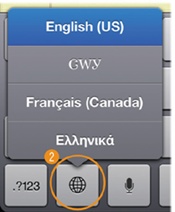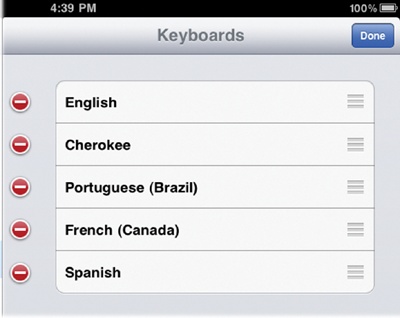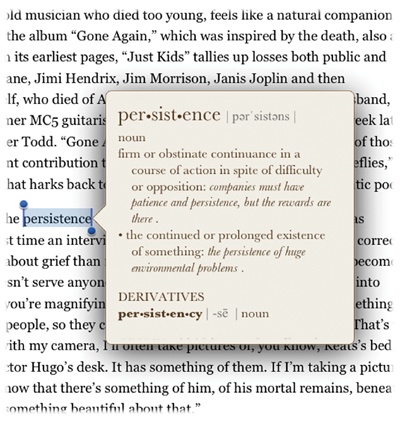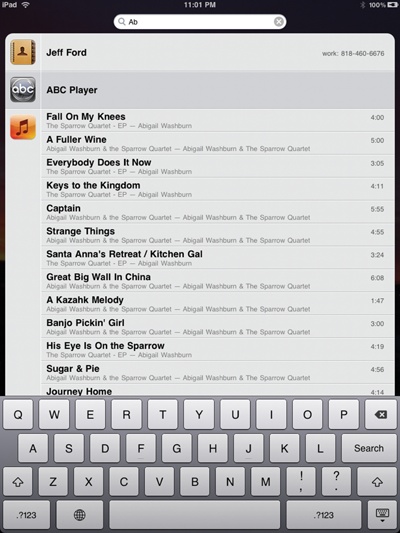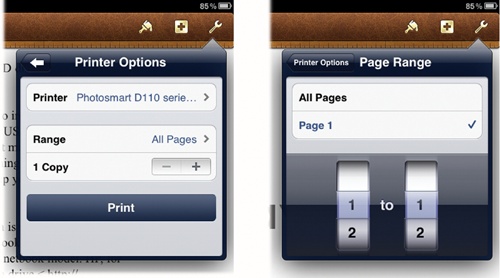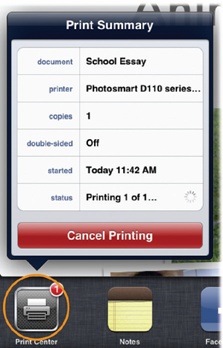Chapter 3. Interact with Your iPad
You’ll learn to:
Do the digit dance to control your iPad
Use keyboard shortcuts
Have Siri execute commands and take dictation
Cut, copy, paste, and spell-check text
Print out your files
THESE DAYS, YOU FIND touchscreens everywhere: on ATMs, plane- and train-ticket kiosks, and even in some fast-food joints. So the iPad’s touch-screen—full-size or Mini—is pretty familiar territory for most of us.
But using an iPad takes more than touch. You tap, you flick, you swipe, you double-tap, you drag, you press-and-hold. Which motion you make and when you make it depends on what you’re trying to do. And that’s where this chapter comes in.
Over the next few pages, you’ll learn how to do the digit dance so your iPad responds to your every command. And what could be easier or more direct than entering text into apps like Mail and Notes simply by talking? Yes, the latest tablet even handles dictation thanks to Siri, the iPad’s virtual assistant, which can do a whole lot more than just type for you.
You’ll also pick up a few keyboard shortcuts here, learn how to find stuff fast on your ’Pad, and find out how to print files you’ve been working on. So clear your throat and get those touchy fingers limbered up by turning the page.
Finger Moves for the iPad
THE “BRAIN” BEHIND THE iPad—its operating system—is smart enough to respond to a series of very different touches. The ones you make depend on what you want to do. Here are the moves:
Tap. Take the tip of your finger and lightly press an icon, thumbnail image, song title, or control you see on-screen. The iPad isn’t a crusty old calculator, so you don’t have to push hard; a gentle touch does the trick.
Drag. Keep your fingertip pressed down on the glass and slide it to go to different places on the screen. That’s how you pan around a photo, for example, and adjust the Pad’s volume slider. A two-finger drag scrolls a window within a window, like the floating window that pops up over your Facebook screen when you call up your Friends list.
Slide. A slide is like a drag, except that you use it almost exclusively with one special control—the iPad’s Unlock/Confirm button, which sits in a “track” that guides your slide as you wake your iPad from sleep or confirm a total shut-down.
Flick. Lightly and quickly whip your finger up or down the screen and watch a web page or song list whiz by in the direction of your flick. The faster you flick, the faster the screen scrolls by. In a photo album, flick side-to-side to see your images parade triumphantly across your screen.
Finger spread and pinch. To zoom in on part of a photo, document, or web page, put your thumb and index finger together, place them on-screen, and then make a spreading motion across the glass. To zoom out, put your spread fingers on-screen and pinch them together.
Double-tap. This two-steppin’ tap comes into play in a few situations. First, it serves as a quick way to zoom in on a photo or web page. Second, if you’re watching a video, it lets you toggle between aspect ratios—the full-screen view (top right), where the edges of the frame get cropped off, and the widescreen, letterboxed view (bottom right), which movie lovers favor because that’s what the director intended a scene to look like. Cinephiles, prepare to double-tap.
Use the Standard iPad Keyboard
THE IPAD HAS NO physical keys—unless you buy the optional keyboard (see Add an External Keyboard). A virtual keyboard, therefore, is the traditional way to enter text.
The iPad’s keyboard pops up whenever you tap an area of the screen that accepts input, like the address bar of a browser, the text area of a new email message, or a search box.
To use the keyboard, just tap the key you want. As your finger hits the glass, the light-gray target key flickers to a darker gray.
The keyboard works in portrait (vertical) mode, but it’s roomier in landscape
(horizontal) view. You can also split the keyboard in half to
thumb-type, as on a smartphone keypad; see Use the Split Keyboard. The button with the
![]() icon (circled above) hides the keyboard.
icon (circled above) hides the keyboard.
The keyboard has a few other special keys:
Shift (
 ). When you tap this key, the normally clear
arrow turns blue (
). When you tap this key, the normally clear
arrow turns blue ( ) to show you it’s activated. When you see the
blue arrow, the next letter you tap appears capitalized. Once you
type that letter, the
) to show you it’s activated. When you see the
blue arrow, the next letter you tap appears capitalized. Once you
type that letter, the  key returns to normal, signalling that the
following letter will show up in lowercase.
key returns to normal, signalling that the
following letter will show up in lowercase.Backspace (
 ). This key deletes in all kinds of
ways: Tap it once to delete the letter just to the left of the
blinking cursor. Hold it down to delete repeatedly, zapping each
letter as you go. Finally, hold it down a bit longer and delete
entire words instead of just letters.
). This key deletes in all kinds of
ways: Tap it once to delete the letter just to the left of the
blinking cursor. Hold it down to delete repeatedly, zapping each
letter as you go. Finally, hold it down a bit longer and delete
entire words instead of just letters. . Tap this button to insert
punctuation or numbers. The keyboard switches from alphabet mode to
serve up a grid of numerical and grammatical symbols. Tap the same
key—which has now become
. Tap this button to insert
punctuation or numbers. The keyboard switches from alphabet mode to
serve up a grid of numerical and grammatical symbols. Tap the same
key—which has now become  —to return to the alphabet. (Happily, there’s
a faster way to get a number or symbol—touch and hold the
—to return to the alphabet. (Happily, there’s
a faster way to get a number or symbol—touch and hold the
 key, and then drag your finger to the
character you want.)
key, and then drag your finger to the
character you want.)When you switch to the numbers/symbols keyboard, a new keyboard button—
 —appears. Tap it to invoke a
third keyboard layout, which offers more
obscure characters, like the # and % symbols, bullets, and
brackets.
—appears. Tap it to invoke a
third keyboard layout, which offers more
obscure characters, like the # and % symbols, bullets, and
brackets.
When you type letters into a web form (or any place that’s not a web address), the iPad adds a Return key to the keyboard so you can move from one line to the next. This key morphs to say Join when you type in a WiFi password, Go when you enter a URL, and Search when you query the search box.
iPad Keyboard Shortcuts
AS YOU’VE PROBABLY DISCOVERED by now, the iPad keyboard has to get a bit creative to fit all the keys you need on a small patch of glass. But face it, when you’re trying to finish an email message, jumping around between keyboard layers to find an ampersand or apostrophe gets old fast. To help balance economy and efficiency, Apple built in a number of keyboard shortcuts and tricks.
Web addresses. When you type a web address into Safari, the iPad’s web browser, the keyboard helpfully includes keys for commonly used characters. For example, you get a slash, underscore, hyphen, and, best of all, a .com button (circled). Not going to a .com address? Press and hold the .com button to get your choice of .edu, .org, or .net, and slide your finger over to the one you want. When you finish, tap the Go button.
Instant apostrophes. The iPad fills in the apostrophe in many contractions, so if you type cant, the tablet corrects it to can’t.
Bad aim. Finger on the wrong key? If you haven’t lifted your digit off the screen yet, slide it over to the correct key and let go.
Punctuation. The iPad’s press-and-slide trick works in a couple of other places as well. Need an apostrophe instead of that comma key on the main keyboard? Press the comma key and slide. Need an ampersand but don’t want to tap all the way into the
 keyboard? Press the
keyboard? Press the  key and slide over to the character without
taking your finger off the keyboard—or having to switch back to the
ABC keyboard.
key and slide over to the character without
taking your finger off the keyboard—or having to switch back to the
ABC keyboard.Accented characters. Need an accented letter, say an é instead of a plain old e? Press and hold the e character to reveal a whole bunch of accented choices. Slide your finger to select the one you need. This trick works on most letters that take accent marks.
Tip
If you don’t look at the text on-screen as you merrily type along—and therefore don’t notice the iPad’s auto-corrections until after it makes them—you can have the tablet pipe up and verbally announce its word suggestions. Just go to Settings→General→Accessibility→Speak Auto-text→On. You turn the feature off here, too.
Auto-Capitalization. Turn this setting on (at Settings→General→Keyboard), and the iPad automatically capitalizes the first letter after a period.
Auto-Correction. The iPad’s dictionary tries to automatically correct typos and spelling errors as you tap along. If you want to accept the suggested correction for a word you just typed, hit the space bar and keep going. Don’t agree with the iPad? Tap the suggested word to reject it. Proper nouns often make the iPad’s dictionary overeager to help, but if you reject its suggestions enough times, it eventually learns what you want. In some programs, words the iPad still finds suspicious get underlined in red; tap them to see alternate spellings. One word of advice: Proofread any text you create before you pass it along—especially in rapid-fire apps like Messages (Send Messages). Auto-Correction has been known to change innocent typos into embarrassing ones. (If the constant autocorrections bug you, turn them off at Settings→General→Keyboard→Auto-Correction→Off.)
Speaking of the Settings area, the iPad tucks away several helpful shortcuts there, too. Go to Settings→General→Keyboard to see them.
Check Spelling. The iPad flags misspelled words in Mail and text apps with a red underline. Tap the flagged word to see replacement options.
Enable Caps Lock. If you NEED TO TYPE LIKE THIS FOR A WHILE, flip on this setting. Now, when you double-tap the Shift (
 ) key, it turns blue and keeps capitalizing
until you tap it again to turn it off.
) key, it turns blue and keeps capitalizing
until you tap it again to turn it off.“.” Shortcut. With this setting turned on, you just double-tap the space bar at the end of a sentence to insert a period and move one space to the right to start your next sentence with a capital letter.
The Keyboard Settings area has other helpful features, like international keyboards (Use an International or Emoji Keyboard) and the split keyboard (Use the Split Keyboard), that make it easier to type while holding the iPad in your hands. But now that you’ve mastered keyboard shortcuts, how about learning some multitasking shortcuts? Just turn the page.
Use Multitasking Gestures on the iPad
THE IPAD’S HOME BUTTON offers a reliable way to go back to the tablet’s Home screen, switch to a different app, or launch a new one. Yes, that Home button can really get a workout. Wouldn’t it be great if there were a quick on-screen way to change apps without fumbling around for a physical control?
As of iOS 5 and later, there is. The iPad offers multitasking gestures—full-fingered moves on the touchscreen—as an alternative to pushing the Home button for certain tasks. With four or five fingers (depending on what you’re most comfortable with) grazing the glass, you can jump around between apps and always return to the iPad’s Home screen.
Your iPad should be set up to do these fancy finger moves by default. But if you try them out and nothing happens except personal frustration, go to the Home screen and tap Settings→General→Multitasking Gestures→On.
Here’s what you can do and how the multitasking gestures work:
Return to the Home screen. This is probably the gesture you’ll use most often because returning to the Home screen is one of the most frequent trips you’ll make on the iPad. Say you’ve got an app open—Safari, Mail, or whatever—and you want to close it to go do something else. With your hand open, put all four fingers and your thumb on the screen and draw all your digits together—like going from a friendly wave to a crab-claw formation. As you pinch your hand together, you’ll see the open app shrink and fade, and your iPad’s Home screen materialize out of the background. By the time your fingers come together, you’re on the Home screen.
Switch between open apps. Just as you can swipe from one Home-screen page to another to see all your apps, so you can swipe from one open app to another to multitask with a vengeance. Say you’re writing a note in Mail and open Maps to look up an address. You can zip back to Mail by placing all your fingers on-screen and swiping from right to left. To go back to your most recently used app or apps (Maps in this example), swipe those fingers from left to right—until you can swipe no further.
Open the bottom panel to switch apps. As explained on Use the Home Button to Switch Apps, you can double-click the iPad’s Home button to open a panel at the bottom of the screen to switch to another app—all without making an interim stop at the Home screen. But if double-clicking the Home button to reveal the apps panel is too much effort, use the official multitasking gesture: Put all your fingers on the screen and swipe them upwards. When you do, the apps panel pops up, ready for you to pick a recently used app.
Multitasking gestures may not be for everyone, especially if you put a lot of fingers on-screen anyway and don’t want to accidentally switch between open apps or constantly end up climbing out of the apps drawer. But they save a lot of time otherwise spent pushing the Home button. And if you decide multitasking gestures aren’t for you, just hit the Home button the old-fashioned way and tap your way through to Settings→General→Multitasking Gestures→Off.
Command Your iPad with Siri
IT’S A BUSY WORLD and everybody needs a little help sometimes. Imagine how great it would be if you could ask the iPad to take on a task, like automatically adding your next dentist appointment to your calendar or firing up a text message to remind your spouse to bring home cat treats after work—just like those people with iPhones running Apple’s Siri virtual assistant software.
Now, the good news for many iPad owners: Siri has arrived. To use this sassy little helper program with the big personality, you need:
The latest hardware, like the iPad Mini from November 2012 or the Retina display models that arrived in March and November 2012.
The latest iPad operating system: iOS 6 or later
An active Internet connection.
Once you have all that, you’re ready to make Siri work for you. The feature is turned on and ready to go by default if you’re running iOS 6, but if you want to make sure, visit Home→Settings→General→Siri and confirm that Siri is set to On.
Using Siri
On the surface, summoning Siri is simple: hold down the iPad’s Home button until you hear two beeps and the program appears on-screen with a cheery “What can I help you with?” note above a microphone. This indicates that Siri is here and ready to serve.
Now it’s your turn to tell her what you want. Since Siri works with a huge number of apps within iOS 6 (including the Clock, Reminders, and more) you have plenty of options. You can have Siri:
Show you directions to a place on a map
Post a comment to Facebook or Twitter, or send a Message
Look up movie times—and even buy tickets online through Fandango
Search the Web
Check your calendar
Play a song by a certain artist
In fact, Siri can do so much, you may not know where to start. If
you don’t know what you want—but would just like to see what
Siri can do—tap ![]() on the right side of the screen. This brings up
a list of the things Siri does, with short examples of how to ask for
them properly so you’re schooled in Siri-speak.
on the right side of the screen. This brings up
a list of the things Siri does, with short examples of how to ask for
them properly so you’re schooled in Siri-speak.
Once you ask for something, Siri does her best to perform the task or find the information requested. If she can’t, she apologizes politely in her sincere little lady robot voice. (And don’t ask her to “open the pod bay doors,” either—she’s a little sensitive about HAL 9000 jokes.)
Customizing Siri
Siri works best when she understands who you are, where you live, who you’re related to, and other little details about your life. When the program has this information, you can say, “Call my wife” or “What good pizza places are near work?” and Siri goes into action because it already knows who to call and where you work.
To add this information, tap Home→Settings→General→Siri→My Info. You’ll see your own card from your Contacts list, where you can fill in your home and work addresses. If you use Siri as a guide to show you nearby businesses, you need to have the iPad’s Location Services feature (Sounds) activated; just go to Settings→Privacy→Location Services→On so Siri knows where you are.
Siri is powerful—but she can also use up a lot of power. To turn her off when your iPad’s battery is feeling low, go to Home→Settings→General→Siri→Off.
Enter Text By Voice
TYPING IS ONE WAY to enter text, but if you have an iPad from 2012 and at least iOS 5 running on it, you can add text to apps like Mail, Notes, and Reminders just by talking. Yes, the iPad takes dictation, and you can use it with chatty third-party apps, too, like Facebook and Twitter. In iOS 6, Siri assumes full command of your dictation needs. (And if you have an iPad from 2012 and haven’t updated it to iOS 6 yet, see Update Your iPad’s Software for instructions.)
To use the built-in Siri and the dictation feature, you need a couple of things:
An Internet connection. You can use either a WiFi or a 4G/3G cellular connection. The iPad does its voice-to-text conversion with the aid of software on a remote server, so it needs a lifeline to the ’Net.
Siri or Dictation enabled. If you didn’t choose to turn on Siri (iOS 6) or the Dictation (iOS 5) when you were marching through the setup screens on your freshly unboxed iPad (left), you can activate it by tapping Home→Settings→General→Siri→On as shown on the previous page. (In iOS 5, tap Home→Settings→General→Keyboard→Dictation→On.)
Once you do, you’re ready to dictate. Siri doesn’t work for every language, but you can speak up in American/British/Australian English, German, French, Italian, Korean, Japanese, and a few Spanish and Chinese dialects by adjusting your Siri preferences in the iPad’s Settings area (General).
Using Dictation on the iPad
When you’re ready to speak your mind into an iPad app, tap into
the text-entry area (like the body of a Mail message) to summon the
keyboard. Tap the microphone icon (![]() ) next to the space bar. Don’t see the
) next to the space bar. Don’t see the
![]() anywhere? Make sure your iPad is connected to
the Internet, because the microphone doesn’t reveal itself without
’Net access. Also note: dictation doesn’t work for web
addresses.
anywhere? Make sure your iPad is connected to
the Internet, because the microphone doesn’t reveal itself without
’Net access. Also note: dictation doesn’t work for web
addresses.
Once you tap the microphone (circled above), start speaking in a clear, loud voice into the front of the iPad. If you need to add punctuation to your recitation, just say the name of the character you need, like period, comma, question mark, quote (or unquote), and slash. Say new paragraph when you need one, or at sign when you’re addressing a message and need a curly little @.
The iPad quietly records your voice as you dictate. When you finish, tap
![]() again. The iPad pauses (and displays a set of
glowing purple dots in the text-entry location) as it sends your words
out for text conversion. Then it plops all the spoken-word text onto
the screen.
again. The iPad pauses (and displays a set of
glowing purple dots in the text-entry location) as it sends your words
out for text conversion. Then it plops all the spoken-word text onto
the screen.
If you need to pick up where you left off, tap
![]() again and continue talking. You can later use
the keyboard in traditional finger-based mode to correct any errors in
the iPad’s transcription.
again and continue talking. You can later use
the keyboard in traditional finger-based mode to correct any errors in
the iPad’s transcription.
Dictation Options for Older iPads
Got an older iPad and want it to transcribe your words when you speak? Visit the App Store (detailed in Chapter 8) and type dictation into the search box. A few dozen apps pop up, including the free, well-reviewed Dragon Dictation (shown below). Or search for Vlingo, an iPhone app that scales up to iPad size and offers some virtual-assistant help for commanding apps by voice.
Use the Split Keyboard
IT MAY TAKE A few days to get used to typing on the keyboard’s slick glass surface, but most people get the hang of it pretty quickly with the tablet on a table, a lap, or propped up in its case. But if you’re one of those types who likes to hold the iPad at all times, you probably get hand cramps from trying to balance the tablet on your fingers while pecking out letters awkwardly in thumb-yoga stretches—unless you have an iPad Mini and small mitts.
Stretch no more! Thanks to the iPad’s handy split keyboard, you can virtually yank the keyboard in half and type much more comfortably on two chunks of keys positioned much closer to your thumbs.
To split your keyboard in two, put a finger on each half of the ’board and drag your digits in the opposite direction from each other. The keyboard senses this move and splits in two, with a batch of keys clinging to either side of the screen—and in much easier reach of your tapping thumbs.
If you have your hands full of iPad and can’t do the two-finger split, just tap the little ridged area on the Keyboard button (circled right) to get an Undock/Split menu you can tap with one finger. After you tap Undock, press your thumb on the ridges of keyboard key to drag the ’board vertically up and down the screen until it’s in a comfortable place.
You can use the split keyboard in either portrait or landscape orientations. Once you finish typing and want to re-join the two halves of the keyboard, put a finger on each set of keys, and slide them toward the middle of the screen. Or just tap “Dock and Merge” (circled below).
Add an External Keyboard
IT’S OKAY, YOU CAN admit it. You tried and tried and tried, but you just can’t deal with that flat-glass typing surface. Your fingers long for the tactile feel of softly clicking Chiclet keys, especially when you work on huge documents or programs that require lots of text entry.
If this describes you, fear not. You can get the comfort of a physical keyboard, and you even have a couple of options.
Bluetooth Keyboard
The iPad conveniently has a Bluetooth chip tucked inside it, so you can use the slab with a Bluetooth-enabled wireless keyboard, like the stylish $69 model Apple makes (shown here), or a more portable variation, like the $99 ZAGG Logitech iPad keyboard-and-case combo. To get the iPad ready for a wireless keyboard in iOS 6, choose Settings→Bluetooth→On (or, in iOS 5, choose Settings→General→Bluetooth→On). Then follow the instructions that came with your particular keyboard to pair your ’board and iPad—this usually means holding down a button until something blinks.
The iPad looks around for nearby devices and should find the
keyboard singing its Bluetooth siren song. When you see the keyboard
in the Devices list, select it and type in any passkey numbers it
requests to complete the connection (check your keyboard manual for
the code). The Bluetooth icon (![]() ) and keyboard name appear on-screen to announce
their pairing. To go back to the virtual keyboard, choose
Settings→Bluetooth→Off (or Settings→General→Bluetooth→Off in iOS 5) or
press the Eject key on the Bluetooth keyboard.
) and keyboard name appear on-screen to announce
their pairing. To go back to the virtual keyboard, choose
Settings→Bluetooth→Off (or Settings→General→Bluetooth→Off in iOS 5) or
press the Eject key on the Bluetooth keyboard.
iPad Keyboard Docks
If a wireless keyboard doesn’t suit you, it’s also possible to find wired keyboards designed for the iPad on accessory sites. These keyboard docks plug into the iPad’s bottom port, but with Apple beginning to change that port on its devices from the traditional 30-pin Dock Connector port to the smaller 8-pin Lightning port, make sure you get a keyboard dock designed for your particular iPad.
Use an International or Emoji Keyboard
IF AMERICAN ENGLISH IS your only language, you can skip these next two pages. But if, over the course of your iPadding day, you find yourself communicating in French, Spanish, German, Russian, Chinese, Japanese, Cherokee, Dutch, Flemish, Italian, Canadian French, or British English, you can add a keyboard layout that reflects the standards of those languages. You can also use the built-in Emoji keyboard to add cute little smiley faces and other icons to text.
To give your iPad some global input:
Tap Settings→General→Keyboard→International Keyboard, and then tap Add New Keyboard.
Peruse the list of languages and tap the one you want, or select “Emoji” if you want to express yourself graphically. “German,” for example, adds a German-character keyboard. The iPad includes the keyboard in your list of personal ’boards at Settings→General→Keyboard→International Keyboard→Keyboards.
You get your choice of keyboard layout, too (QWERTY, AZERTY, or QWERTZ). To pick one, tap the language name in your list of keyboards. If you plan to use an external keyboard as well (or instead), you can select a hardware layout, too, like the one for a Bluetooth keyboard that uses the standard German character map or the Dvorak layout.
Once you add and configure your new keyboards, call them up when you need to leap into a memo in Dutch or Japanese:
You switch keyboards two ways:
First, you can tap the key with the globe icon (circled) just to the left of the space bar. With each tap, you cycle through your personal keyboards as their names flash by on the space bar. Stop when you see the keyboard you want.
Alternatively, you can press down on the globe key for a minute to pop up a list of all your keyboards, then slide your finger up to the one you want.
Then, type away. To switch back to English or another keyboard language, go to the globe.
Delete a Keyboard
To delete an international keyboard you no longer use:
To rearrange the order in which your keyboards appear in the
globe menu, use the grip strip icons (![]() ) to drag them into the desired new world order.
Then tap the blue
) to drag them into the desired new world order.
Then tap the blue ![]() button in the top-right corner.
button in the top-right corner.
Note
The iPad offers several languages that use non-Western character sets, including Japanese, Chinese (Simplified) Pinyin, and Chinese (Simplified) Handwriting. “Handwriting on a keyboard?” you wonder. No problem for the iPad: When you select Chinese (Simplified) Handwriting as your keyboard, your screen becomes a virtual touchpad where you can enter Chinese character strokes with the tip of your finger. The iPad sees what you’re doing and offers a list of matching characters to choose from.
Cut, Copy, Paste, and Replace Text
THE IPAD’S ABILITY TO move text and images around within a document (or between documents) is useful, but it’s not the tablet’s most intuitive feature. And no, you can’t use Ctrl-C to copy something because the keyboard has no Control key. Never fear, here’s how you move text and images from place to place—or program to program:
To cut or copy text that you can edit (like an outgoing email message or a note), double-tap a word to highlight it. A Cut | Copy | Paste | Suggest | Define box pops up. (You see the Define option only when you have a single word selected. Tapping it opens the iPad’s dictionary; see Use the iPad’s Global Dictionary for more on word lookup.) To select more words to copy, drag the blue dots on either end of the selected word. Then tap Cut or Copy. (If you select more than one word, you don’t see the Suggest option either; the next page explains.)
For pages you can’t edit (like incoming emails), hold your finger down until you see a magnifying glass and insertion-point cursor. Drag it to the text you want to copy. When you lift your finger, a Select or Select All box appears. Select highlights the underlying word and displays the blue dots so you can include more text or even photos. Select All highlights everything on-screen. Either way, lift your finger to get a Copy button. Web pages work a little differently: When you lift your finger there, you skip the Select options and go right to the Copy button, as shown above.
Tap the spot where you want to paste the text or photo to call up the Paste button. You can even jump to a different program; tap within it to paste.
Tap Paste to copy the text or pic into the new location, file, or program.
Make a mistake and wish you could undo what you just did? Tap the
![]() key and hit Undo on the numbers keyboard. Or just
give the iPad a quick shake and tap the Undo Paste or Undo Typing button
that appears.
key and hit Undo on the numbers keyboard. Or just
give the iPad a quick shake and tap the Undo Paste or Undo Typing button
that appears.
But be careful when you shake that iPad—you don’t want to send your $500 high-tech tablet flying across the room because you pasted the word “celery” on the wrong line of a recipe.
In addition to the Cut, Copy, and Paste options in apps where you can edit text (like Notes or Mail), you can replace a misspelled word with one spelled correctly. Or you can replace one word with a different word altogether. To get to these options, double-tap or select a word on-screen. When the Cut | Copy | Paste | Suggest | Define box appears, tap Suggest. The iPad offers up a few alternate words, as shown below. If you see the word you meant to type in the list, tap it to replace the text.
But enough about text—want to copy a photo or video into a message-in-progress or some other program? Hold your finger down on the screen until the Copy button pops up, as shown in the screenshot below. Tap Copy, create an email, and then tap the message body to get a Paste button. Tap it to insert your image or video into the file.
To copy multiple items, like pictures in a photo album, tap the
Edit button in the top-right corner. Next, tap the photos you want to
copy; blue checkmarks (![]() ) appear in the thumbnail corners to indicate your
selection. Tap the Share button on the top-left side of the toolbar, tap
Copy, and switch to the program where you want to deposit your pics
(like an open mail message). Then press the glass until you see the
Paste button.
) appear in the thumbnail corners to indicate your
selection. Tap the Share button on the top-left side of the toolbar, tap
Copy, and switch to the program where you want to deposit your pics
(like an open mail message). Then press the glass until you see the
Paste button.
Tip
The iPad’s Notes app is a handy place to stash text when you find something from a web page or email message you want to keep. If you use Outlook 2007 or 2003 for Windows, or the Mail program that comes with Mac OS X 10.5.7 or later, you can sync your notes back and forth between your iPad and desktop computer. Just connect the iPad to your computer, click its icon in the iTunes Source list, and click the Info tab. Scroll down and turn on the Sync Notes checkbox, and then click Apply. You can also sync Notes by way of iCloud (Chapter 17).
Use the iPad’s Global Dictionary
AS YOU MAY HAVE noticed from tapping text to cut, copy, paste, or replace misspelled words, a Define option can also appear in the pop-up menu. This launches the iPad’s global dictionary, a built-in reference that works with most apps. It defines words in real time, so you need an Internet connection for it to work.
Using the dictionary is easy—when you see a word you don’t recognize in a text-oriented app like Safari or Mail, tap it twice (or press and hold it for a second) to select it. Then tap the Define option from the pop-up menu. The dictionary quickly looks up the word and presents the definition right there in a pop-up box.
Some words may have long and varied definitions, so flick down the box to see all the noun, verb, adjective, and adverb forms. And some words, like “superior,” may double as place names, as in Superior, Wisconsin. Tap the background text you started from to dismiss the dictionary and continue reading, armed with your newfound knowledge.
Tip
Do you use certain words or phrases all the time in written correspondence? You know, like “please see attachment” or “talk to you later”? If so, iOS 5 and later has a nifty Shortcuts feature buried in the Settings screen that saves you time and typing. With Shortcuts, you can tell your iPad that when you type “ttyl,” it should automatically expand that to “talk to you later.” (Fans of the TextExpander utility are gleefully rubbing their hands together at this point.)
To set up a new shortcut, tap Settings→General→Keyboard. Down in the Shortcuts end of the screen, tap Add New Shortcut. In the Phrase box, type the full set of words you want to appear when you type in your shortcut, like “See you tomorrow.” In the Shortcut box, type in the letters you want to use as your quick-entry text, like “syt,” and then tap the Save button in the upper-right corner.
If you ever want to go back and change your shortcut phrases or abbreviations, return to Settings→General→Keyboard and, in the Shortcuts list, tap the one you want to adjust, and edit away. And if you’re tired of the iPad taking it upon itself to incorrectly fix certain words all the time, consider making shortcuts out of the valid words to prevent those embarrassing autocorrections.
Search the iPad
ONCE YOU GET YOUR iPad fully loaded, you may actually want to find something on it—a certain song in your music library, a calendar appointment, or someone’s address, for example. If you have 128 gigabytes of stuff on a bulging iPad, you may not want to wade around looking for a nugget of information. You can, however, shine the Spotlight on it.
Spotlight is the iPad’s built-in tool for introspection and self-searching. It lets you scan your iPad for words, apps, phrases, names, titles, and more. You can call up songs, appointments, email messages with directions to a house party, and all sorts of other things. You get to Spotlight a few ways:
If you’re on your first Home screen, press the Home button to call up Spotlight.
If you’re a few Home screens deep, flick backwards from left to right until you pass your first Home screen and arrive at the Spotlight screen, where you can flick no further.
Once you’re on the Spotlight screen, type the name or words you’re looking for (“Doctor Lee” or “Harrigan” or “Gettysburg”). Spotlight searches as you type, narrowing its results as you continue. On the results screen, tap any item to open it. You can even launch one of your apps from the list—which is a great way to fire up programs after you fill up your 11 Home screens with app icons and don’t have any place to display new ones. Flick to the bottom of the list, and you also get the option to search for your topic on the Web and Wikipedia via Safari. And in iOS 6, you can get Siri to do the searching for you (Command Your iPad with Siri).
Tip
Tired of songs by The Smiths popping up when you search for messages from your cousins—also named Smith? You can fine-tune your Spotlight search results to weed out certain types of files. Just tap Home→Settings→General→Spotlight Search and turn off the checkmarks next to items like Music or Videos.
Print with Your iPad
YOU PRETTY MUCH HAVE two ways to print messages, photos, and other documents from your iPad: apps or AirPrint.
The App Store (Chapter 8) offers dozens of utility programs that let you print files from your iPad on your home printer. Some may be more elegant than others, but odds are you can find something in the Store that’ll have you printing for less than $10.
If you’ve never searched the Store for an app, Search for Apps shows you how; type print into the App Store’s search box and go to town. When you find an app that appeals to you from its description and reviews, buy it, install it, and follow the app’s directions for printing.
The other way to print uses Apple’s AirPrint technology. This approach can be more expensive—you need a compatible printer—but ultimately easier to use because the technology is built into your iPad, so you’re not at the mercy of a third-party app.
AirPrint now works with more than 75 printer models—many of them made by HP, with assorted models from Brother, Canon, Epson, and Lexmark playing along. (You can see a full list at http://support.apple.com/kb/ht4356.)
Once you have a compatible printer, here’s how AirPrint works:
If you just bought an AirPrint-ready printer to use with your iPad, follow the printer’s setup instructions for adding it to your wireless network. (You may have to upgrade certain models, like the HP Photosmart D110a, with a firmware update from the manufacturer; check the printer’s manual for specific steps.)
Pick a file on your iPad that you want to print. AirPrint works with Mail, Safari, iBooks, and pictures from both the Photos and Photo Booth apps. Other apps from the App Store, like iWork (Chapter 11) and the note-organizing Evernote, also offer the Print option. With a file open, tap
 and choose Print to launch the Printer
Options box. (In Mail, tap
and choose Print to launch the Printer
Options box. (In Mail, tap  ; in the iWork suite, the Print command lives
under the Tools icon of each app in the Share and Print
menu.)
; in the iWork suite, the Print command lives
under the Tools icon of each app in the Share and Print
menu.)Tap Printer. The iPad searches your network for AirPrint machines and presents you with a list of the ones it finds. Tap the name of a printer to select it, and then tap the Printer Options arrow to go back to the printer settings box.
With your printer now selected (above left), tap Range to choose the pages you want to print. By default, you get All Pages, but if it’s a long web page or file, you can change that (above right). Tap the Printer Options button to go back to the printer settings box. There, tap the + and - buttons to increase or decrease the number of copies you print.
Tap the Print button and listen for the sound of your printer whirring.
Once you configure AirPrint the first time, the iPad remembers your printer and offers it as the default choice the next time you need to make paper.
Managing Print Jobs
Like other computers, the iPad shows you how many print jobs you have lined up. It also lets you cancel a job if you change your mind—or realize you told the iPad to print 12 copies instead of two.
To see your print queue, double-click the Home button and swipe through the apps panel until you see the Print Center icon (circled at right). Tap the icon to see a summary of your print job (or jobs) waiting in line for its trip to the printer. Tap Cancel Printing to stop a job and save that ink and paper for another time.
Tip
Have no plans to get an AirPrint printer and don’t want to deal with apps? The Web has its own creative workarounds if you don’t mind fiddling. One is Netputing’s AirPrint Activator for Mac OS X (netputing.com/airprintactivator), which lets iOS devices see and use a network printer; you can find a Windows version with a quick Web search.

